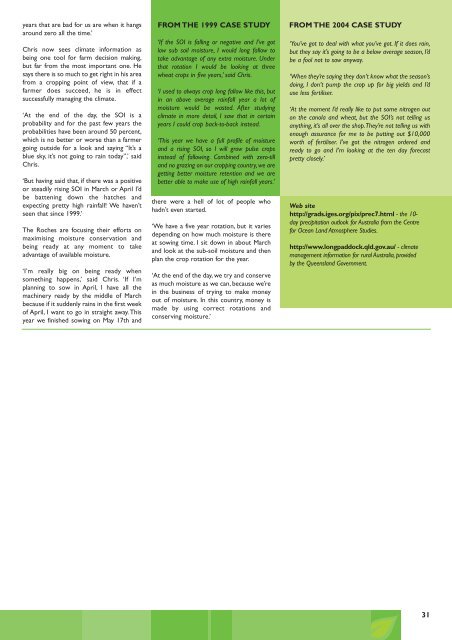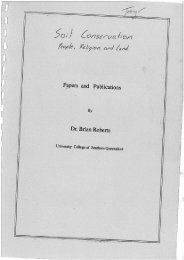Masters of the Climate: Innovative farmers ... - South West NRM
Masters of the Climate: Innovative farmers ... - South West NRM
Masters of the Climate: Innovative farmers ... - South West NRM
Create successful ePaper yourself
Turn your PDF publications into a flip-book with our unique Google optimized e-Paper software.
years that are bad for us are when it hangs<br />
around zero all <strong>the</strong> time.’<br />
Chris now sees climate information as<br />
being one tool for farm decision making,<br />
but far from <strong>the</strong> most important one. He<br />
says <strong>the</strong>re is so much to get right in his area<br />
from a cropping point <strong>of</strong> view, that if a<br />
farmer does succeed, he is in effect<br />
successfully managing <strong>the</strong> climate.<br />
‘At <strong>the</strong> end <strong>of</strong> <strong>the</strong> day, <strong>the</strong> SOI is a<br />
probability and for <strong>the</strong> past few years <strong>the</strong><br />
probabilities have been around 50 percent,<br />
which is no better or worse than a farmer<br />
going outside for a look and saying “It’s a<br />
blue sky, it’s not going to rain today”,’ said<br />
Chris.<br />
‘But having said that, if <strong>the</strong>re was a positive<br />
or steadily rising SOI in March or April I’d<br />
be battening down <strong>the</strong> hatches and<br />
expecting pretty high rainfall! We haven’t<br />
seen that since 1999.’<br />
The Roches are focusing <strong>the</strong>ir efforts on<br />
maximising moisture conservation and<br />
being ready at any moment to take<br />
advantage <strong>of</strong> available moisture.<br />
‘I’m really big on being ready when<br />
something happens,’ said Chris. ‘If I’m<br />
planning to sow in April, I have all <strong>the</strong><br />
machinery ready by <strong>the</strong> middle <strong>of</strong> March<br />
because if it suddenly rains in <strong>the</strong> first week<br />
<strong>of</strong> April, I want to go in straight away. This<br />
year we finished sowing on May 17th and<br />
FROM THE 1999 CASE STUDY<br />
‘If <strong>the</strong> SOI is falling or negative and I’ve got<br />
low sub soil moisture, I would long fallow to<br />
take advantage <strong>of</strong> any extra moisture. Under<br />
that rotation I would be looking at three<br />
wheat crops in five years,’ said Chris.<br />
‘I used to always crop long fallow like this, but<br />
in an above average rainfall year a lot <strong>of</strong><br />
moisture would be wasted. After studying<br />
climate in more detail, I saw that in certain<br />
years I could crop back-to-back instead.<br />
‘This year we have a full pr<strong>of</strong>ile <strong>of</strong> moisture<br />
and a rising SOI, so I will grow pulse crops<br />
instead <strong>of</strong> fallowing. Combined with zero-till<br />
and no grazing on our cropping country, we are<br />
getting better moisture retention and we are<br />
better able to make use <strong>of</strong> high rainfall years.’<br />
<strong>the</strong>re were a hell <strong>of</strong> lot <strong>of</strong> people who<br />
hadn’t even started.<br />
‘We have a five year rotation, but it varies<br />
depending on how much moisture is <strong>the</strong>re<br />
at sowing time. I sit down in about March<br />
and look at <strong>the</strong> sub-soil moisture and <strong>the</strong>n<br />
plan <strong>the</strong> crop rotation for <strong>the</strong> year.<br />
‘At <strong>the</strong> end <strong>of</strong> <strong>the</strong> day, we try and conserve<br />
as much moisture as we can, because we’re<br />
in <strong>the</strong> business <strong>of</strong> trying to make money<br />
out <strong>of</strong> moisture. In this country, money is<br />
made by using correct rotations and<br />
conserving moisture.’<br />
FROM THE 2004 CASE STUDY<br />
‘You’ve got to deal with what you’ve got. If it does rain,<br />
but <strong>the</strong>y say it’s going to be a below average season, I’d<br />
be a fool not to sow anyway.<br />
‘When <strong>the</strong>y’re saying <strong>the</strong>y don’t know what <strong>the</strong> season’s<br />
doing, I don’t pump <strong>the</strong> crop up for big yields and I’d<br />
use less fertiliser.<br />
‘At <strong>the</strong> moment I’d really like to put some nitrogen out<br />
on <strong>the</strong> canola and wheat, but <strong>the</strong> SOI’s not telling us<br />
anything, it’s all over <strong>the</strong> shop.They’re not telling us with<br />
enough assurance for me to be putting out $10,000<br />
worth <strong>of</strong> fertiliser. I’ve got <strong>the</strong> nitrogen ordered and<br />
ready to go and I’m looking at <strong>the</strong> ten day forecast<br />
pretty closely.’<br />
Web site<br />
http://grads.iges.org/pix/prec7.html - <strong>the</strong> 10-<br />
day precipitation outlook for Australia from <strong>the</strong> Centre<br />
for Ocean Land Atmosphere Studies.<br />
http://www.longpaddock.qld.gov.au/ - climate<br />
management information for rural Australia, provided<br />
by <strong>the</strong> Queensland Government.<br />
31
















